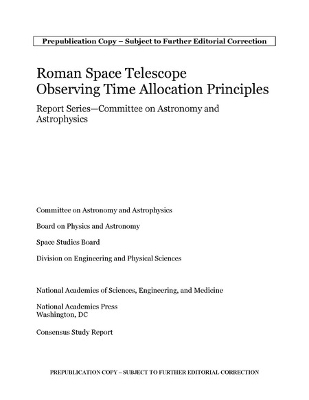
Roman Space Telescope Observations
Report Series?Committee on Astronomy and Astrophysics
Seiten
2023
National Academies Press (Verlag)
978-0-309-69450-6 (ISBN)
National Academies Press (Verlag)
978-0-309-69450-6 (ISBN)
- Titel z.Zt. nicht lieferbar
- Portofrei ab CHF 40
- Auch auf Rechnung
- Artikel merken
The Roman Space Telescope will measurably advance knowledge of dark energy and exoplanet demographics. Locally, it will likely enhance understanding of the structure and substructure of the Milky Way and nearby galaxies, including a census of the predicted but elusive ultra-faint dwarf galaxies. At high redshift, it can provide information on the topology of reionization and the abundance of sources like active galactic nuclei and pair-instability supernovae. With a wavelength range of 0.48-2.3 ?m, the Roman Wide Field Imager has the largest etendue of any existing or planned optical/infrared space observatory. The coronagraph technology demonstration instrument will pioneer new capabilities that will be the basis for future instruments capable of directly detecting and characterizing Earth-like planets around nearby stars. If the technology demonstration is successful, observations with the coronagraph could make substantial advances in the study of planetary and disk systems.
At the request of NASA, this report reviews the Roman Space Telescope science program to set the appropriate mix of survey time devoted to the three Core Community Surveys (which address the weak lensing, baryon acoustic oscillations, supernovae, and microlensing programs in NWNH) relative to guest investigator-led observing programs during the primary 5-year mission.
Table of Contents
Front Matter
Executive Summary
1 Introduction
2 Findings and Conclusions
3 An Example of Combining Collaboration and Competition
4 Maximizing Flexibility
5 Summary and Response to the Charge
Appendixes
Appendix A: Statement of Task
Appendix B: Letter of Request
Appendix C: Acronyms and Abbreviations
Appendix D: Biographies of Committee Members and Staff
At the request of NASA, this report reviews the Roman Space Telescope science program to set the appropriate mix of survey time devoted to the three Core Community Surveys (which address the weak lensing, baryon acoustic oscillations, supernovae, and microlensing programs in NWNH) relative to guest investigator-led observing programs during the primary 5-year mission.
Table of Contents
Front Matter
Executive Summary
1 Introduction
2 Findings and Conclusions
3 An Example of Combining Collaboration and Competition
4 Maximizing Flexibility
5 Summary and Response to the Charge
Appendixes
Appendix A: Statement of Task
Appendix B: Letter of Request
Appendix C: Acronyms and Abbreviations
Appendix D: Biographies of Committee Members and Staff
| Erscheint lt. Verlag | 7.7.2023 |
|---|---|
| Verlagsort | Washington |
| Sprache | englisch |
| Maße | 216 x 279 mm |
| Themenwelt | Naturwissenschaften ► Physik / Astronomie ► Astronomie / Astrophysik |
| Technik ► Luft- / Raumfahrttechnik | |
| ISBN-10 | 0-309-69450-7 / 0309694507 |
| ISBN-13 | 978-0-309-69450-6 / 9780309694506 |
| Zustand | Neuware |
| Haben Sie eine Frage zum Produkt? |
Mehr entdecken
aus dem Bereich
aus dem Bereich
Grundlagen, Anwendungen in Astrophysik und Kosmologie sowie …
Buch | Softcover (2022)
Springer Spektrum (Verlag)
CHF 69,95
die Geschichte und Erforschung unserer Galaxie
Buch | Hardcover (2023)
C.Bertelsmann (Verlag)
CHF 40,80
Von Hubble-, James-Webb- und anderen Großteleskopen bis zu …
Buch | Softcover (2024)
Springer (Verlag)
CHF 32,15


